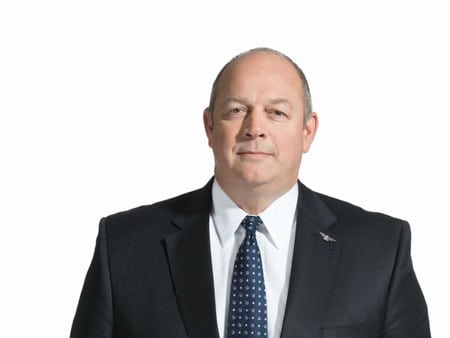 |
| Delta Air Lines Senior Vice President of Flight Operations Steve Dickson. Photo: Delta Air Lines |
[Avionics Today 04-26-2016] Delta Air Lines Senior Vice President of Flight Operations Steve Dickson opened the 2016 Avionics Maintenance Committee (AMC) / Airline Electronic Engineering Committee (AEEC) Conference with a keynote speech that outlined the carrier’s Communications Navigation and Surveillance (CNS) philosophy. According to Dickson, certain aspects of modifying the Delta aircraft fleet to operate with NextGen and Single European Sky-related technologies are improving flight operational efficiencies. Still others, such as implementing new transponders and other related equipment to comply with the 2020 mandated equipage for Automatic Dependent Surveillance-Broadcast (ADS-B), have been challenging.
Dickson’s speech came on the first day of the 2016 AMC/AEEC conference, hosted by Delta, where ARINC industry activities standards making subcommittees have gathered to discuss progress on form, fit, function, data and other key aspects of avionics hardware and software that help move industry innovation and contribute to improved flight operational efficiency. The Delta executive also gave an update on the airline’s NextGen equipage rates.
“Delta has committed tremendous resources into making our fleet NextGen capable, many modifications are already employed and many are planned for the future. These equipage initiatives can be challenging to say the least. We have to make the business case to justify the modifications and we are competing with other priorities around the business case that may deliver immediate and concrete benefits in terms of operational performance. Often the issues are compounded by a strained supply chain trying to supply the entire industry with the same equipment that are solutions to some of these issues,” said Dickson.
Delta operates a fleet of 800 aircraft and averages 15,000 flights per day, and carried 180 million passengers while generating $40.7 billion in revenue in 2015. Dickson credits a lot of the airline’s efficiency to NextGen upgrades, and also gave the AMC/AEEC audience some insight on the carrier’s CNS philosophy.
“Our CNS philosophy addresses these major initiatives, leveraging existing equipment to the maximum extent possible for unit operational benefits. We call this NowGen. Our CNS philosophy is communication through [Controller Pilot Datalink Communications] CPDLC and [Future Air Navigation System] FANS, navigation throughout performance-based navigation, which has several flavors to it, [including] [Required Navigation Performance] RNP, [Required Navigation Performance Authorization Required] RNP AR and even basic [Area Navigation] RNAV. Then surveillance which currently is ADS-B Out, we expect these NextGen benefits to improve safety, reliability and customer service all while reducing emissions and lowering fuel burn, with respect to safety, our CNS strategy reduces operational variability,” said Dickson.
On the communications side, Delta has been one of the earliest adopters of FANS CPDLC avionics to take advantage of the FAA’s earliest phase of it’s DataComm program, with the Departure Clearance (DCL) functionality being introduced at some of the busiest airports throughout the National Airspace System (NAS) this year.
“Just think of it as text messaging instead of talking on VHF, HF voice communications. FANS helps alleviate one more step where a mistake can happen where a pilot or controller can misinterpret what is said causing initial radio chatter, deviations and delays. We’re currently using CPDLC for Departure Clearance or DCL in daily operations,” said Dickson.
Delta will have more than 250 aircraft equipped by year’s end, including a number of domestic 737s, which operate mostly in the domestic airspace. DCL is currently being used and is scaled rapidly by the FAA on the airline’s Boeing 767-400 and 777 fleets on flights that operate out of New York and Los Angeles. DCL is also scheduled for implementation at Delta’s hub in Atlanta, Ga., later this year.
The biggest equipment challenge facing Delta right now are factors surrounding the FAA’s airspace mandate requirement for aircraft that fly above 10,000 feet to be equipped with ADS-B Out avionics.
“Currently Delta has 179 of its 800-plus aircraft equipped with the new transponder but this number is increasing everyday. Delta plans to be compliant by the implementation date however some of the major hurdles we will need to overcome consist of supplier constraints, late availability of Multi-Mode Receivers (MMRs) and recently delivered aircraft that require GPS modifications, all of which have made the process longer than it really needs to be. All these changes cost Delta well over $100 million including man-hours equipment and service time. You can see how just one aspect of the NextGen program affects Delta as one operator in the National Airspace System in terms of time and money,” said Dickson.